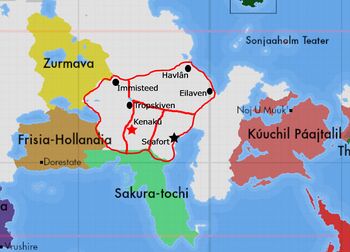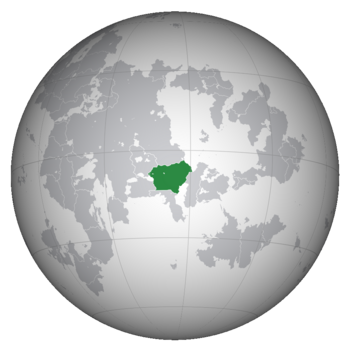Fresian Confederacy
This article is incomplete because it is pending further input from participants, or it is a work-in-progress by one author. Please comment on this article's talk page to share your input, comments and questions. Note: To contribute to this article, you may need to seek help from the author(s) of this page. |
The Confederation of Fresia | |
|---|---|
Motto: "They’ll be peace without end, every neighbour a friend. Every man, a king." | |
Royal anthem: God Save The Queen
| |
 Map of the Fresian Confederacy | |
 Location of the Fresian Confederacy | |
| Location | Near Eastern Olivacia |
| Capital | Seafort (National) Kenakû (Royal) |
| Largest | Seafort |
| Official languages | English |
| Recognised national languages | French |
| Ethnic groups (2021) | (75%) Fresian (25%) Other |
| Religion (2021) | (25%) Christian (15%) Other (60%) Secular |
| Demonym(s) | Fresian |
| Government | Parliamentary Constitutional Monarchy |
• Monarch | Princess Anette |
• Prime Minister | George Clinton |
• Chief of Staff | Nate Webley |
| Legislature | Parliament |
| Chamber of Ministers | |
| House of Representatives Hall of Governors | |
| Establishment | |
• Founding of Muorre Strjitte Alliânsje | 1250 CE |
• Muorre Strjitte Ryk | 1500 CE |
• The Revolution of 1812 | 1812 CE |
| Area | |
• Total | 1,260,259 km2 (486,589 sq mi) |
| Population | |
• 2022 estimate | 82,269,707 |
• 2021 census | 80,656,576 |
• Density | 64/km2 (165.8/sq mi) |
| GDP (PPP) | 2021 estimate |
• Total | 2,980,220,100,000 ACU |
• Per capita | 36,225 ACU |
| GDP (nominal) | 2021 estimate |
• Total | 2,782,651,975,500 ACU |
• Per capita | 34,500 ACU |
| Gini (2021) | 33.3 medium |
| HDI (2021) | very high |
| Currency | Fresian Dollar (WSD) |
| Time zone | UTC+7 & +8 (WST) |
| Driving side | right |
| Calling code | +50 |
| Internet TLD | .ws |
Fresian Confederacy The Fresian Confederacy is located in Eastern Olivacia, Anteria and shares a border with Zurmava, Frisia-Hollandia, Sakura-tochi. The national capital city of the Fresian Confederacy is Seafort, with the royal capital city being in Kenakû where the Royal family has been residing since 1812. Other metropolitan areas in the Fresian Confederacy include but are not limited to; Immisteed, Tropskiven, Havlân, and Eilaven.
The Fresian Confederacy is a formidable power on the east side of Olivacia with both a strong military and many trade networks internationally. After the Red Revolt, the private sector had experienced slow growth in the economy as lighter restrictions were passed for businesses and international trade. The Fresian Confederacy is one of the biggest providers of commodity goods and natural resources. The Wall Street Republic has made moderate contributions to science and technology, with major prioritization of creating trading networks to set the Fresian Confederacy as one of the leading trading partners in the world. Fresian Confederacy's Human Development Index is considered very high with an average life expectancy of 80 years old.
Etymology
Internationally, the Fresian Confederacy’s citizens are known as Fresians, the reasoning behind the FC’s name when the name Fresia started to appear in the 1810s as anti-monarchy revolutionaries looked for a name to separate them from the Muorre Strjitte Ryk. Ultimately combining Free and Frisia and coming up with Fresia. When the revolutionaries won the The Revolution of 1812, they all came together as a Confederation and declared themselves the Fresian Confederacy.
History
Prehistory
The first signs of humans related to the Wall Street Republic can be traced back to 600 BC when Frisians and Germanics moved into the eastern part of Oliviacia and started to form a mixed cultural sphere. This cultural sphere was acknowledged and known by settlers as Eastfryslân. Not much is written down about these early years, but what is known is that they settled into small communities around 500-400 BC and grew gradually into provinces around 150 BC-50 AD.
Muorre Strjitte Age
In 1250 AD, the princes and lords of Eastfryslân gather in a chamber to discuss an alliance between the realm. Alexander Hearsen has gathered all the lords of the land to try to convince them to become one big kingdom. This struck many lords’ interest and many came personally while others sent their princes to the meeting, the alliance proposed a military pact to those who joined as well as a trade union for its merchant members. Most of the realm signed in and formed the Muorre Strjitte Alliânsje.
This alliance did indeed become something bigger like Alexander had promised, as the alliance pushed further eastward towards Eastlikmar. They opened many ports, notable ones being Tropskiven and Havlân. In 1500 AD all the lords and nobles collectively came together and unanimously voted to become a true empire, instead of an alliance. They renamed themselves the Muorre Strjitte Ryk with Lady Fenja Hearsen as the royal figurehead of the empire. This kingdom flourished in trade and expansion on both land and sea.
Gewoan Maitiid Age
In 1812, revolutionaries known as the Free Frisian Army overthrew the monarchy. The FFA renamed the country as Fresia and was split into 2 parties, Democratic and Republican. 78 years later, they would form into the Confederation of Fresia, having more smaller parties under the two powerhouses in Fresian politics which is becoming bigger and bigger as the nation was modernizing and forming a more unified culture as a whole.
During 1915, a Socialist revolution known as the Red Revolt was crushed by a combination of OSO, MIA and NFA efforts, this called on the Red Scare and allowed the government to suppress most socialist parties and activities until the 2000s.
Modern Age
Geography
The Fresian Republic is 1,260,259 km2, with the climate being tropical at most. The Fresian Confederacy is mostly a tropical savanna with a few tropical forest to the west of the Fresian Confederacy border.
Politics
The Fresian Confederacy is a Constitutional Monarchy where the monarch has been reduced to a figure head or until 1990, held provincial power like a mayor but still is able to act like a monarch. Elected PM George Clinton is the current leader of the Fresian Confederacy with Chief of Staff Nate Webley.
The Fresian Confederacy follows a democratic voting system called Trigstinepas which requires any law or legislation to be pass through the House of Representatives, Hall of Governors, and the Chamber of Ministers in that order and pass with 51% of the members having voted for it.
The Fresian Confederacy’s legislative body is a Tricameral Parliamentary system which consists of the House of Representatives that has 251 seats and is elected by popular vote using a single transferable vote system every 4 years. The Hall of Governors which consists of all the mayors and governors that is recognized by the Fresian Confederacy and is elected through popular vote using a single transferable vote system every 2 years. The Chamber of Ministers which consists of all the ministers of different departments of state including the royal family and Chief of Staff. The office of Prime Minister holds executive power over the whole country and it’s politics, and is elected through elections by popular vote using a Two-Round vote system where the top two candidates of the first election get to move on the second election while everyone else is eliminated from the election. There is also a system called Corrupgeprof that can remove anyone from office if the
There are many political factions in the Fresian Confederacy, but the major political powerhouses are the Fresian Democratic Party and the Republican Conservatives Party ever since 1812. Though these powerhouses are big on their own, coalitions and back door deals have been happening ever since the 1900s
| Color | Name of the Political Factions | Representative | Political Ideology | Number of Seats | Coalition/Unaffiliated |
|---|---|---|---|---|---|
| Fresian Democratic Party | Roy Demetre | Representative democracy Radical Populism |
126 / 251
|
Alliance For Democracy | |
| Republican Conservatives Party | Bradley Herald | Republican Democracy Democratic Capitalism |
75 / 251
|
Fresian Transnationals | |
| Proletariat Union of Fresia | None | Anti-capitalism Proletarian internationalism |
23 / 251
|
People’s Resistance Against Corruption | |
| Fresian Nationalist Party | Poldi Rudolf | Totalitarianism Imperialism |
17 / 251
|
Fresian Transnationals (Temporally) | |
| Centerlist Front | Carl Devins | Centrism | 10 / 251
|

